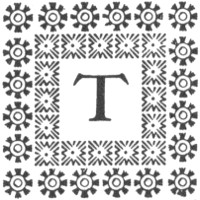
THE
PRINTER
in Eighteenth-Century
WILLIAMSBURG
An Account of his Life & Times, & of his Craft
Williamſburg Craft Series
WILLIAMSBURG
Publiſhed by Colonial Williamſburg
MMI

A Word to the Reader about Eighteenth-Century Typography

The paragraphs on this Page and thenext have been ſet in an eighteenth-centuryManner. The Type uſed is Caſlon, developedin the early Part of the eighteenth Centuryby William Caſlon, the greateſt of the EngliſhLetter Founders. Caſlon in 1734 iſſued his firſt BroadſideSpecimen Sheet of Type Faces cut at his Foundry duringthe preceding Decade and a Half.
Although Caſlon is famous for the beautiful Type thatbears his Name, he deſerves equal Credit for deſigning ſomeof the moſt handſome Type Ornaments or “Flowers” everdeveloped, before or after his Time. Such Type Flowershad many Uſes—to embelliſh Initial Letters at the Beginningof a Chapter in a Book; as decorative Devices in aſingle Row over a Type Heading ſtarting a new Page in aBook; or over Headings each Time a new Subject wasintroduced in a Text. Flowers were caſt to all the regularBodies of the Letter from the ſmall (Nonpareil) to thelarge (Great Primer) Size. The Type Flowers uſed at theHead of this Page, in the built-up Initial opening the firſtParagraph, and elſewhere in this Publication are reproducedfrom original eighteenth-century Flowers excavated at theSite of the Printing Office on Duke of Glouceſter Street inWilliamſburg.
The longs “s” ſo evident in theſe Paragraphs originated inthe German Hand Script. Early German Type Founders attemptedto reproduce Handwriting as cloſely as poſſible.In the Attempt the long “s” was evolved and was adoptedby the firſt Engliſh Printers who learned their Trade fromthe Germans. The long “s” remained in general Uſe untilabout the Year 1800. It was always uſed at the Beginningand in the Middle of a Word, but never to terminate a Word.It can eaſily be recognized by the Fact of having onlyhalf a Croſſbar or none at all, whereas the Letter “f” hasa full Croſſbar.
Ligatures, ſuch as ct, ſb, ſſ, ſi, ſſi,ſk, ſl, ſſl, ſt, fi, ffi, ff,fl, ffl, were developed where a long “s” or an “f” overlappedthe following Letter. Caſting the two Characters togetheravoided Damage to the overlapping Letter. Although ſomeLigatures have fallen into Diſuſe, the fi, ffi,ff, fl, and ffl are ſtill common today.
Printers alſo applied, through much of the Century, ſomeRules of Style which the modern Reader may find odd if notawkward. For Example, they began all Nouns with a capitalLetter, thus diſtinguiſhing them from other Parts of Speechſuch as Adjectives, Verbs, &c. In the ſame Faſhion, theycapitalized Expreſſions of particular Emphaſis, and Titlesof Honor and Eminence. The Names of Perſons and Pl